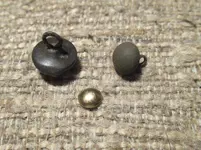I have now seen it all. Officially. I was detecting with a friend at a couple sites yesterday and today. It's the start of deer hunting season, so we were being extra vigilant and trying to stay out of their way. There was this one soybean field we like, it was like the Indy 500 with cars there. First the farmer with the manure spreader. Fortunately, he didn't have enough for MOST of the field! Whew! Then a guy came in, we waved, he was putting up a deer stand. A little bit later, another car came in, he was checking his traps for foxes (he got two). I have mixed feelings on that, but he has every right to harvest them. Then we detected some more and then TWO more cars come in. We gave it up and left at that point. You'd think that bean field was the cat's meow.
Findings were slim. My friend found a musket ball on this site which dates to the 1700's. He also got a couple buttons and buck loads. I hadn't gotten much except for about 6 of the hand made buck and ball loads and a broken tombac button and a small brass tack.
We moved closer to the edge of the field and I got a solid signal on the Deus. It was very solid, but a small target. I dig anything that reads over "40" on the meter, this was about a 65. I dug a fairly shallow hole as I knew the whatever it was, was going to be little. It was only about 1" down. Opening the small plug I get the glimmer of bright gold. Hello? GOLD color? On this colonial house site with little evidence of ANYTHING ever happening there after the house was destroyed ca 1780? I mean come on! For instance, this site is so clean, I have only found two pulltabs on it. Ever.
I take it over to my friend, break open the little clump of dirt and sitting pretty is a high karat front half of a typical hollow 17th century gold button! It's about 1/4" in diameter. This button style was widely used 1650-1700 or so. I have some in my collection in base metal, but this blew me away. For the rest of the day I second guessed myself as to what it would be otherwise, but took it to a group dig and everybody there confirmed my suspicion as solid gold, and 17th century.
17th Century gold. Never in my wildest dream, even if it's only the front of the button. They were welded in the center, and the shank applied and some were solid cast.
It is shown here in comparison to the same style 17th century buttons made of other base metals. What's next? (Better not think of Unicorns.)
Findings were slim. My friend found a musket ball on this site which dates to the 1700's. He also got a couple buttons and buck loads. I hadn't gotten much except for about 6 of the hand made buck and ball loads and a broken tombac button and a small brass tack.
We moved closer to the edge of the field and I got a solid signal on the Deus. It was very solid, but a small target. I dig anything that reads over "40" on the meter, this was about a 65. I dug a fairly shallow hole as I knew the whatever it was, was going to be little. It was only about 1" down. Opening the small plug I get the glimmer of bright gold. Hello? GOLD color? On this colonial house site with little evidence of ANYTHING ever happening there after the house was destroyed ca 1780? I mean come on! For instance, this site is so clean, I have only found two pulltabs on it. Ever.
I take it over to my friend, break open the little clump of dirt and sitting pretty is a high karat front half of a typical hollow 17th century gold button! It's about 1/4" in diameter. This button style was widely used 1650-1700 or so. I have some in my collection in base metal, but this blew me away. For the rest of the day I second guessed myself as to what it would be otherwise, but took it to a group dig and everybody there confirmed my suspicion as solid gold, and 17th century.
17th Century gold. Never in my wildest dream, even if it's only the front of the button. They were welded in the center, and the shank applied and some were solid cast.
It is shown here in comparison to the same style 17th century buttons made of other base metals. What's next? (Better not think of Unicorns.)

Upvote
22




